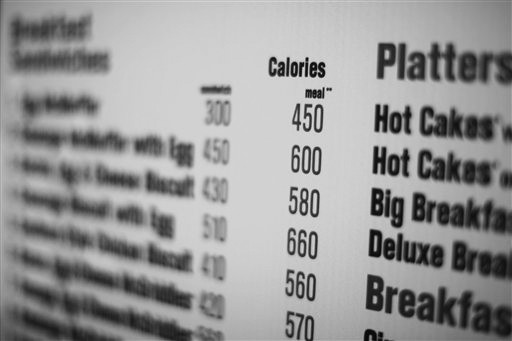
Associated Press File Photo In this July 18, 2008 file photo, calories of each food item appear on a McDonalds drive-thru menu in New York. The new FDA proposal could take effect sometime in 2012, enforcing calorie counts on all fast food menus. (Associated Press File Photo)
Soon, fast-food eateries and restaurant chains across the nation will be giving much more information on their menus for diners.
A new Food and Drug Administration proposal will mandate calorie counts on menus of chain restaurants with 20 or more outlets.
These rules will also apply to bakeries, grocery stores with prepared foods, convenience stores, coffee chains and vending machine products that do not already have nutrition facts clearly shown.
This will require more than 280,000 establishments nationwide to add calorie counts directly to the menu so that it is visible for diners to see at the time of ordering their food.
The FDA claims that because Americans are consuming about one third of their total calories from foods prepared outside of the home, these rules have been proposed in an effort to combat U.S. obesity.
The FDA would like to have consumers well aware of exactly how much they are eating in every meal.
The FDA wants to help fight the growing problem of obesity in America and excess calorie consumption.
Many people have become busier than in the past, and find it hard to make family meals at home, but that does not mean that people should become careless about watching how many calories are going into their food.
Locations where food isn’t the primary business will be exempt from the proposal, such as movie theaters, bowling alleys and airplanes.
And though soft drinks will be included, alcoholic beverages are also exempt.
However, students should be aware of the calories that movie snacks and alcohol can pack.
Movie snacks, like buckets of popcorn and candy can be thousands of calories, so those who frequent the movies should look for alternative treats.
Students can bring sugarfree gum, which can keep them from eating the tempting snacks all together, or they can bring in snacks from home and know exactly what they are munching on during a long movie.
Even those who are careful about everyday food consumption let it slip on the weekends when they are out having a good time.
From a recent weekend drink count done by an SMU student, it was calculated that alcohol alone can add up to 2,000 calories from two nights of drinking.
This is a scary figure when some students are going out up to four times in one week.
Though some students do not want to know how many calories are in a fast food meal when indulging, some believe that it is a step in the right direction.
“I think that the new rules will be beneficial for people because if they are seeing how many calories are going into their fast food meals on a daily basis, they will probably be more conscious of how many calories are going into their meals, and make different choices accordingly,” Devon Wilson, a senior at SMU said.
Currently, nutritional facts are available in obscure places around eateries, such as near a bathroom or in a hallway, and it would be inconvenient for people to leave their meal to find nutritional facts.
With the new rules, restaurant goers will be able to see the exact calorie count in everything they are buying at the time of purchase.
Other nutritional data, like sodium and saturated fat content, are required to be available on request.
The FDA hopes to sway consumers away from higher calorie choices while grabbing quick meals, and encourage healthier choices, which many fast-food restaurants have started to offer.
Along with many nutritionists nationwide, The National Restaurant Association endorsed the rules, saying they are going to provide consistency for consumers.
Menu boards will also inform restaurant goers that the general nutritional advice is given based on a 2,000 calorie diet and that individual diet needs may vary.
Some states have already started to put the new rules in place.
New York was the first to make clear calorie counts available on menus, some cities in California and Washington State have also followed suit.
Most have positive responses to the new signage, because while Americans are becoming busier, the U.S. population is also becoming more accepting and aware of health information.
Some eateries around SMU, such as Starbucks, have already started posting calorie counts on menus to help their customers make informed decisions when choosing coffee drinks and other snack items.
The new rules could come into effect in 2012, and will apply to menus, both in restaurants and drive-through lanes. Though it will be some time before the new rules are in place nationwide, students can take beneficial steps toward choosing wisely and knowing their calorie consumption.
Students who are eating most of their calories outside of the home, should be careful about the potential calories in their food, and should ask the establishments for nutritional information.











